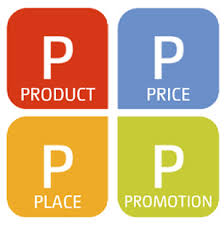The Marketing mix is a set of four decisions which need to be taken before launching any new product. These variables are also known as the 4 P’s of marketing. The marketing mix consists of-
Product
Price
Place
Promotion
Marketing Mix 4p’s

The marketing mix principles are controllable variables which have to be carefully managed and must meet the needs of the defined target group. All elements of the mix are linked and must support each other.
PRODUCT STRATEGIES
When an organization introduces a product into a market they must ask themselves a number of questions.
- Who is the product aimed at?
- What benefit will they expect?
- How do they plan to position the product within the market?
- What differential advantage will the product offer over their competitors?
Three levels of a product
Level 1: Core Product. What is the core benefit your product offers? Customers who purchase a camera are buying more than just a camera they are purchasing memories.
Level 2: Actual Product. All cameras capture memories. The aim is to ensure that your potential customers purchase your one. The strategy at this level involves organizations branding, assessed features and benefits to ensure that their product offers a differential advantage from their competitors.
Level 3: Augmented Product. What additional non-tangible benefits can you offer? Competition at this level is based around after sales service, warranties, delivery. A retail departmental store that offers a free five year guarantee on purchases of their TV sets, gives their customers the additional benefits of “peace of mind” over the five years should their purchase develop a fault.

Product Decisions
When placing a product within a market many factors and decisions have to be taken into consideration. These include:
Product Design: Will the design be the selling point for the organization as we have seen with the iphone, blackberry
Product Quality: Quality has to be consistent with other elements of the marketing mix. A high quality product maybe reflected in the price.
Branding: A brand is defined as “a name, term, sign, symbol or a combination of these, that identifies the maker or seller of the product” A brand must stand out and be recognizable, and should help the firm differentiate itself from its competitors.
Product Features: Additional features should increase the benefit offered to your target market. The firm may decide to charge more for these additional features.
PRICING STRATEGIES
Is one of the most important elements of the marketing mix. It is the only mix which generates a turnover for the organization. The remaining 3p’s are the variable cost for the organization. It costs to produce and design a product, it costs to distribute a product and costs to promote it.
Pricing is difficult and must reflect the supply and demand relationship. Pricing a product too high or too low could mean a loss of sales for the organization.
Pricing should take into account the following factors:
- Fixed and variable costs
- Competition
- Company objectives
- Proposed positioning strategies
- Target group and willingness to pay
An organization can adopt a number of pricing strategies. The pricing strategies are based on what objectives the company has set itself to achieve.
Penetration Pricing
Where the organization sets a low price to increase sales and market share.
Skimming Pricing
The organization sets an initial high price and then slowly lowers the price to make the product available to a wider market. The objective is to skim profits of the market layer by layer, this strategy is popular within the games console industry.
Competition Pricing
Setting a price in comparison with competitors. A firm has three options, price lower, price the same, or price higher.
Product Line Pricing
Pricing different products within the same product range at different price points. An example would be a DVD manufacturer offering different DVD recorders with different features at different prices. The greater the features and the benefit obtained the greater the consumer will pay. The form of price discrimination assists the company in maximizing turnover and profits
Bundle Pricing
The organization bundles a group of products at a reduced price, this pricing strategy is popular with supermarkets.
Psychological Pricing
The seller will consider the psychology and the positioning of price within the market place. The seller will therefore charge $199 instead of $200.
Premium Pricing
The price is set high to reflect the exclusiveness of the product. An example of products using this strategy would be first class airline services, Porsche etc.
Optional Pricing
The organization sells optional extras along with the product to maximize its turnover. This strategy is used commonly within the car industry.
Discount Pricing
Seasonal Discounts – at various times of the year, companies may reduce the remaining items in stock ie: – Christmas decorations after Christmas, Halloween candy on Nov 1st
Quantity Discounts – customer get a discount for buying in volume ie: buy 2 get 1 free
PLACE
Place Strategies
This refers to how an organization will distribute the product or service they are offering to the end user. The organization must distribute the product to the user at the right place at the right time. Efficient and effective distribution is important if the organization is to meet its overall marketing objectives. If an organization underestimated demand and customers cannot purchase products because of it, profitability will be affected.
What channel of distribution will they use?
Two types of channel of distribution methods are available.
- Indirect distribution involves distributing your product by the use of an intermediary for example a manufacturer selling to a wholesaler and then on to the retailer.
- Direct distribution involves distributing direct from a manufacturer to the consumer For example Dell Computers providing directly to its target customers. The advantage of direct distribution is that it gives a manufacturer complete control over their product.
Distribution Strategies
Depending on the type of product being distributed there are three common distribution strategies available:
1. Intensive distribution: Used commonly to distribute low priced or impulse purchase products eg chocolates, soft drinks.
2. Exclusive distribution: Involves limiting distribution to a single outlet. The product is usually highly priced, and requires the intermediary to place much detail in its sell. An example of would be the sale of vehicles through exclusive dealers.
3. Selective Distribution: A small number of retail outlets are chosen to distribute the product. Selective distribution is common with products such as computers, televisions household appliances, where consumers are willing to shop around and where manufacturers want a large geographical spread.
If a manufacturer decides to adopt an exclusive or selective strategy they should select a intermediary which has experience of handling similar products, credible and is known by the target audience.
PROMOTION STRATEGIES
A successful products or service means nothing unless the benefit of such a product or service can be communicated clearly to the target market.
An organizations promotional mix can consist of:
- Advertising
- Sales Promotion
- Public Relations
- Direct Mail
- Personal Selling
- Internet Promotion
Advertising:
Is any non personal paid form of communication using any form of mass media. For example on TV, Radio, Billboard
Sales Promotion:
Commonly used to obtain an increase in sales short term. Could involve money off coupons or special offers, loyalty cards, coupons, price promotions e.g. point of sales, packaging promotions or web coupons.
Public Relations:
This involves developing positive relationships with the organization media public. the art of good public relations is not only to obtain favourable publicity within the media, but also involves being able to handle successfully negative attention.
Direct Mail:
Is the sending of publicity material to a named person within an organization. The aim of direct marketing is to create one to one relationships with the organizations target market. Direct marketing can come in the form of post, e-mail, telephone calls and mail order. The company usually contacts a named person at the address
Personal Selling:
Selling a product service one to one. This can either be done face to face or over the phone.
Internet Marketing:
The use of the web for the promotion of products or services. This could be the firm advertising via the use of banner ads, flash videos, or Google keywords.















